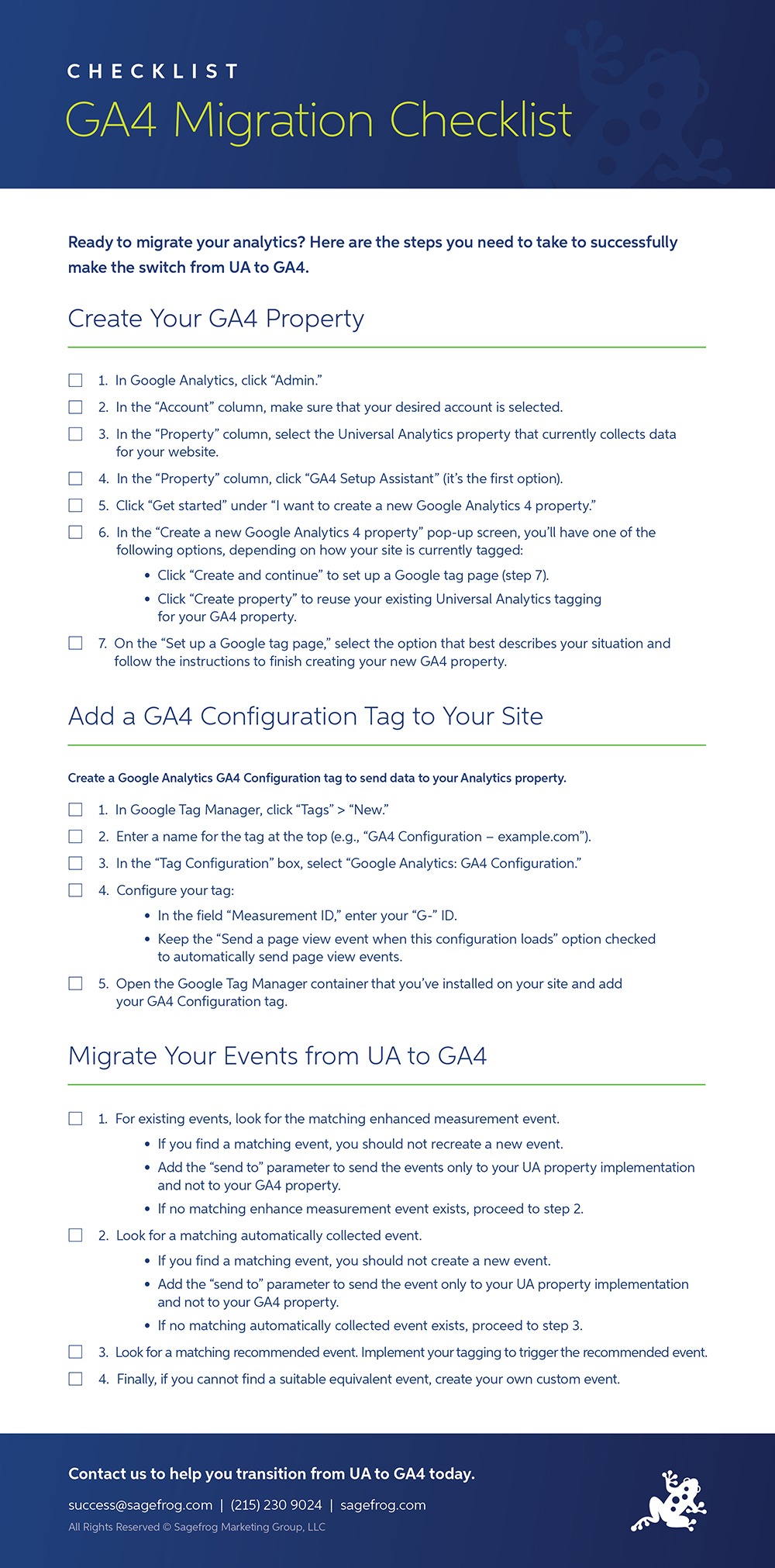The day web analytics professionals have anticipated is almost upon us: on July 1, 2023, Universal Analytics (UA) will no longer report data. Going forward, Google Analytics 4 (GA4) will be your new tool for storing and collecting data.
So, what does this mean for you? If you use UA and haven’t yet switched over, you’ll want to start transitioning your data collection efforts to GA4 as soon as possible. You have until July 1, 2023, to switch, but UA will no longer be collecting data at that point, so delays might cause you to miss out on important metrics.
We know the move to GA4 from UA is big, and that’s why we’re here to help. Learn more about GA4 and use our checklist below for a smooth migration.
Why is Google Dropping UA for GA4?
Humans universally hate change, so it’s natural if your first reaction is to question why UA is ending in favor of GA4. From phone software updates to big platform changes like this one, it’s always frustrating to learn a new normal with the important technology in your life. But there are good reasons for this change. GA4 will have new features that are intended to make your life easier.
According to Google, those new features include:1
- Website and app data collection to better understand the customer journey
- Event-based data tracking instead of session-based data tracking
- Privacy controls such as cookieless measurement and behavioral and conversion modeling
- Predictive capabilities for guidance without complex models
- Direct integrations to media platforms that can drive actions on your website or app
Essentially, Google has decided to build a new analytics platform (GA4) rather than revise the existing one (UA) to add these new features. This is ultimately a positive shift, and once you get your new GA4 property functional, you should be able to see the difference.
Event-Based Data vs Session-Based Data
The main difference between UA and GA4 is how they track and report user interactions with your website or app. UA used session-based data tracking which starts when a user opens your website or app and ends when they close it. All the user’s interactions during a session are attributed to that session, and you can track metrics like the number of sessions, session duration, and bounce rate.
However, GA4 uses event-based data tracking which focuses on tracking individual user interactions or events, such as clicking a button, watching a video, or adding a product to a cart. Each event is tracked separately, and you can use them to measure things like conversion rates, click-through rates, and other user behaviors.
Your GA4 Migration Checklist
Ready to migrate your analytics? Here are the steps you need to take to successfully make the switch from UA to GA4.
Monitor Your Metrics
GA4 isn’t a platform that you can set and forget; to make the most of its advanced features and information, you need to monitor it regularly. Make sure you check in on your settings and metrics with some frequency.
And don’t forget to download your data from UA before you completely move on. Google plans to host your UA data for six months after the July transition to GA4, but it’s always better to be safe than sorry.
Sagefrog’s GA4 Migration Services
At Sagefrog, our robust digital team is the driving force for results. Whether through our responsive websites, captivating ad campaigns, trending content pieces, informative newsletters, front-page Google results, and more—they accelerate success for our clients using the power of analytics and data.
We’re available to help you transition from UA to GA4 starting right away. As your migration partner, we won’t only keep your data running to ensure you don’t miss out on any important metrics, but we’ll help you take advantage of GA4’s new features to squeeze more out of your digital marketing efforts.
So, when it comes to your GA4 transition, analytics data, or anything else—from generating leads to building brand awareness—we’re here to make it happen. Reach out to Sagefrog today to get started.
- Google Analytics Help, “Introducing the next generation of Analytics, Google Analytics 4”
- Google Analytics Help, “Add a Google Analytics 4 property (to a site that already has Analytics)”
- Google Tag Manager Help, “Configure Google Analytics 4 tags in Google Tag Manager”
- Google Analytics Help, “About this event migration guide”




